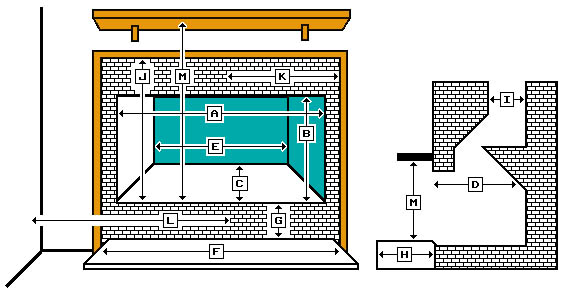
The Chimney Sweep Online Fireplace, Woodstove, Gas Stove and Barbecue Shop

The Chimney Sweep Online Fireplace, Woodstove, Gas Stove and Barbecue Shop

| A: Minimum Fireplace Opening Width.......................... 30" B: Minimum Fireplace Opening Height.......................... 20" C: Minimum Fireplace Depth at Floor......................16-1/4" D: Minimum Fireplace Depth at 20" above Floor.... 16-1/4" E: Minimum Fireplace Width at 16" Depth.............. 24-1/2" F: Minimum Hearth Width........................................ 36-3/4" G: If Fireplace Opening is raised above hearth: no support needed for flush insert H: Minimum Hearth Depth (original fireplace hearth plus extension if needed)......................... 16" I : Stainless steel liner size........................................................................................................... 6" J: Minimum Height from floor of fireplace to Combustible Trim........................................ 36-3/4" K: Minimum Distance from Centerline of Fireplace Opening to Combustible Side Trim.... 20-1/8" L: Minimum Distance from Centerline of Fireplace Opening to Combustible Side Wall... 34-3/16" M: Minimum Height from floor of fireplace to Combustible Mantel.................................... 36-3/4" Area covered by standard (embossed) surround panels............. 26"T x 36"W Area covered by extra-large (not embossed) surround panels... 29"T x 42"W |
| Left: Minimum requirement. If the chimney is properly lined with terra-cotta liner tiles with a 6" x 9" opening or smaller, a direct-connect installation is permitted. Remove damper assembly, cut and anchor a stainless steel sealer plate (removable for cleaning) at the throat of the fireplace. Insert a length of 6" stainless flex long enough to reach into the bottom liner tile through a hole cut in the sealer plate.Advantage: less expensive than full relineDisadvantages: reduced updraft, increased creosote formation, insert must be removed to clean chimney. |
Right: Preferred method, and required for zero-clearance fireplace installations, unlined masonry chimneys, or if existing liner is damaged. Remove damper assembly, install a 6" stainless steel liner the entire length of the chimney, passing through a stainless steel sealer plate at the top of the chimney; finish at top with stainless top clamp, storm collar and rain cap assembly.Advantages: better updraft, better performance, reduced creosote formation, chimney can be cleaned without removing insert.Disadvantage: more expensive to installTo read more about installing your stainless liner, click here. |
|
Note: your mileage may vary! Some code jurisdictions don't allow direct connect insert installations, even if provided for in the Manufacturer's Product Safety Listing. Consult with your local Code Authority. |
